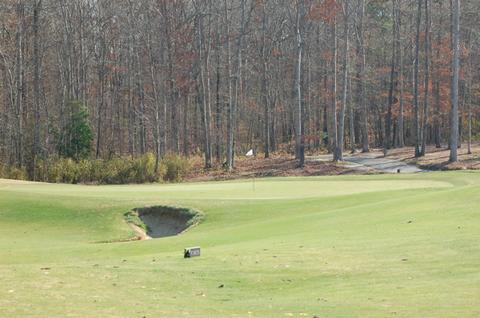
Architect Mike Strantz gives a wink and nod to the renowned Pine Valley, with which Tobacco Road has been compared. His tiny bunker at the 2nd green mimics the Devil's Arsehole at Pine Valley.
I hated Tobacco Road the first time I played it. It might have had something to do with the weather - 35 degrees, sleeting sideways. I held a grudge for the better part of six years. But a week ago Sunday, my son Tim inveigled me to give it another go on our drive back to his college. Under totally different conditions - 60 degrees, sunny with a gentle wind - I felt a little like Alan Shephard taking the most famous swing in history, a drive from a moonscape into the great unknown. Tobacco Road is somewhat otherworldly.
There are no homes adjacent to Tobacco Road, just a few remnants of an old asphalt factory and a hunting cabin. Pinehurst is about 45 minutes away, and there are excellent golf courses even closer, such as Quail Ridge, an Ellis Maples design nearby, and Whispering Pines, another Maples course within 20 minutes.
Tobacco Road is the big kahuna in the area, however, and it is not coy about its mischievous charm. It reveals itself on the very first tee, with two huge hills guarding a narrow gap of fairway 200 yards out. By "narrow," I mean just 15 yards. Fly those hills or else prepare to grab your sand wedge for a small piece of the 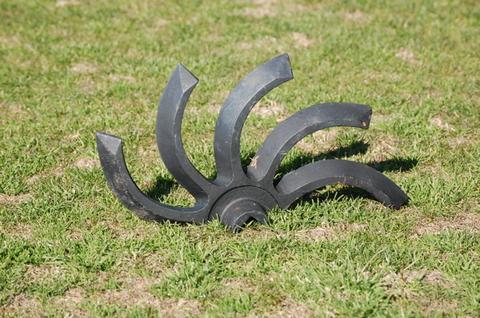 remaining 300-yard approach. After that first hole, the Road is one huge expanse of waste bunkers, interrupted by the occasional patch of green fairway. Overhead views of the fairways in the yardage book are like a bunch of Rorschach blots, with shapes reminiscent of Caspar the (Un)Friendly Ghost, the Headless Horseman and ET. Some holes almost double back on themselves, a few greens at more than right (or left) angles to the fairways.
remaining 300-yard approach. After that first hole, the Road is one huge expanse of waste bunkers, interrupted by the occasional patch of green fairway. Overhead views of the fairways in the yardage book are like a bunch of Rorschach blots, with shapes reminiscent of Caspar the (Un)Friendly Ghost, the Headless Horseman and ET. Some holes almost double back on themselves, a few greens at more than right (or left) angles to the fairways.
Other nutty touches abound. One green is 60 yards deep, another just 16. Some greens are invisible from fairways, including that 16-yard deep one, on the par 5 13th, necessitating a pegboard grid at the edge of the fairway that indicates the pin position. Some long and straight drives are penalized because the fairways taper down to just a few yards.
It would be impossible for even legions of maintenance workers to rake the hundreds of acres of waste bunkers on a daily basis, so Tobacco Road's local rule permits the smoothing of footprints and the re-dropping of balls in the bunkers (and since all bunkers are considered of the waste variety, you may ground your club
The pre- and post-game facilities at Tobacco Road are rather Spartan. The driving range is a good cart drive from the clubhouse and first tee and nothing special, just a warm-up range really. The practice putting green by the first tee is huge, with an immense hump in its middle, wasted space upon which no hole can be placed, but
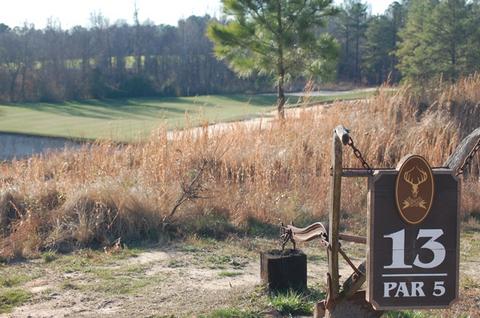 its swoops and swerves serve notice of what awaits out on the course. The clubhouse is modest, and the food and pro shop merchandise is modestly priced. Tobacco Road's employees are a friendly bunch, the starter at the first tee a raconteur eager to share his knowledge of the course and whatever other topics come up. (He chatted us up at length about his time in Lexington, VA, where my son attends college.)
its swoops and swerves serve notice of what awaits out on the course. The clubhouse is modest, and the food and pro shop merchandise is modestly priced. Tobacco Road's employees are a friendly bunch, the starter at the first tee a raconteur eager to share his knowledge of the course and whatever other topics come up. (He chatted us up at length about his time in Lexington, VA, where my son attends college.)Some compare Tobacco Road to Pine Valley. I've had the great fortune to play both, and although The Road is no Pine Valley in degree of difficulty, its forced carries over waste areas, its swirling putting surfaces and the feeling of pleasant exhaustion after the round did bring back some memories. The late Mike Strantz, Tobacco Road's designer, was certainly aware that his track might be compared to the great New Jersey course; he seems to pay homage on his 2nd hole with a copy of the tiny Devil's Arsehole bunker from the 10th at Pine Valley. But Pine Valley is more difficult - much more difficult in my recollection from 15 years ago when I hit the ball 20 yards farther and a little straighter. I shot 88 then playing considerably better than I did at Tobacco Road where I shot 84 with three double bogies.
Conditions on a January Sunday at Tobacco Road were excellent. I am sure the greens are cut a little closer at other times, but they were fast enough on a course where getting close to the pin is a hit or miss. There was
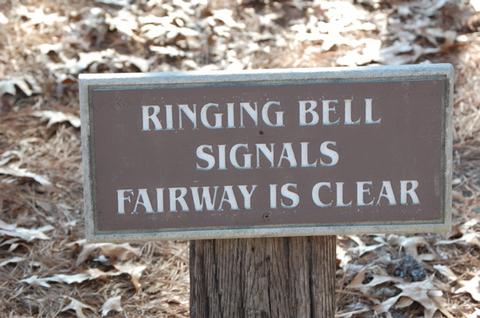 some inconsistency in the texture of the sands on the course, ranging from normal waste bunker sand (a little graininess) to a finer composition, especially around the greens. Occasionally it seemed the course had run out of both and added a red clay and sand mixture to a few bunkers. But when you can smooth the sand and ground your club, sand inconsistency makes less of a difference. My son and I had vowed to "roll ‘em over" in the fairways before the round, but I did not find it necessary to do so more than one time when my tee shot wedged in someone's unfilled divot mark.
some inconsistency in the texture of the sands on the course, ranging from normal waste bunker sand (a little graininess) to a finer composition, especially around the greens. Occasionally it seemed the course had run out of both and added a red clay and sand mixture to a few bunkers. But when you can smooth the sand and ground your club, sand inconsistency makes less of a difference. My son and I had vowed to "roll ‘em over" in the fairways before the round, but I did not find it necessary to do so more than one time when my tee shot wedged in someone's unfilled divot mark.A few other flourishes are worth noting. The course is on former farming land, and it pays homage with plows that display the hole numbers, and in its tee markers - a ripper (appropriately for the back tees), disc, plow, and cultivator. The ripper tees, at just 6,532 yards, are recommended for handicaps of 5 and below. The disc, at 6,300, is deemed appropriate for handicaps from 6 to 14. The differences between the course ratings - which predict how a scratch golfer will score - and the slope, which does the same for bogey golfers, are dramatic. At the tips, the rating is 73.2 (compared with par of 71) and the slope a hefty 150 (Pine Valley's ratings are 74.1 and 154, respectively). From the men's or disc tees, the numbers are 70.8 and 141. A bogey golfer should be quite content from the plow tees at 5,886, with a rating of 68.6 but a slope of 131.
I've changed my mind about Tobacco Road. It is occasionally annoying, but if you can escape its clutches over 18 holes, you will feel a great sense of accomplishment. If some member of Pine Valley wants to invite me back, I'm packed and ready. If not, I will be perfectly content to travel down Tobacco Road in the years to come.
Tobacco Road Golf Club, Sanford, NC. Tel: 877-284-3762. Web: www.TobaccoRoadGolf.com. Green fees from $49 to $134, cart included. Click for location on map.
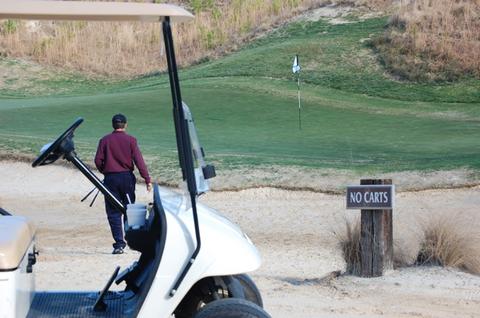
There are only a few sandy places where carts are not permitted at Tobacco Road.























